In recent years, freshwater shrimp have seen a significant rise in popularity among aquarium hobbyists, and for good reason! Shrimp don’t need much space and require little maintenance.
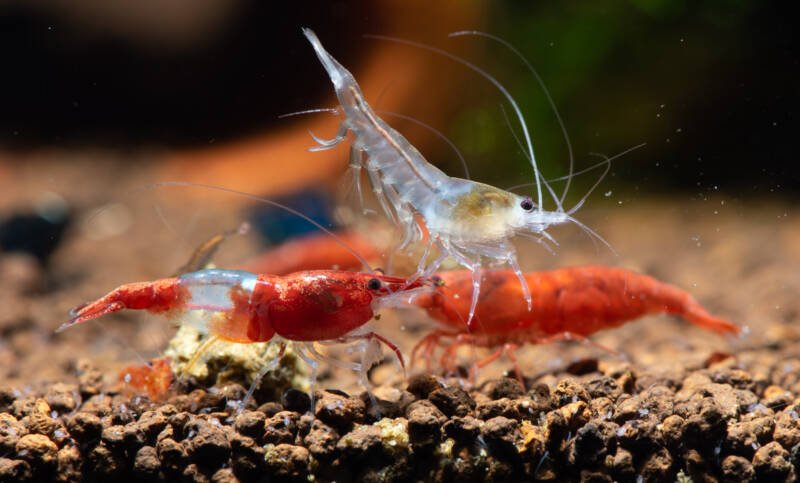
Shrimp tanks are quite a bit different than fish tanks. For one thing, shrimp are much more delicate than fish and are usually very small.
The water conditions need to be right for them to thrive. Plus, some filtration equipment that works for fish can endanger shrimp.
In today’s article, we’ll discuss how to best set up a shrimp tank and have a look at some of the common species in the hobby today!
In this article
A Good Option?
Shrimps are becoming increasingly popular in the trade thanks to their vibrant colors, small size, and ease of breeding. For these reasons and others, they can usually be kept in smaller spaces than fish. Their bioload is also much lower as compared to fish.
One of the big problems shrimp owners face, however, is their sensitivity to water quality. Most individual species have very specific water requirements that can sometimes be hard to maintain.
Otherwise, shrimp tanks can be a fun and challenging project for both beginner and expert hobbyists!
Overview of Dwarf Shrimp
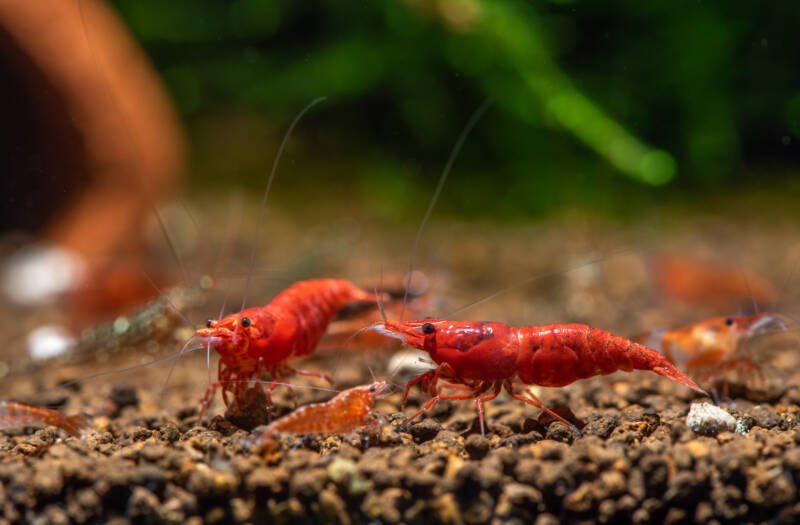
Like most other animals you might keep in an aquarium, there are several species of shrimp that have gained popularity over the years due to their ‘hardiness’ and ease of care.
Unlike fish, however, shrimps (and invertebrates in general), have an exoskeleton that must be shed so that the shrimp can grow.
Many of the more popular species available today do not grow past one inch (2.5 cm) and reproduce readily in a well-maintained home aquarium.
Dwarf shrimp are by far the most popular group of shrimp in the home aquarium business today, mainly due to their small size and vibrant colors.
Up until a few years ago, these shrimp were practically nonexistent in the trade and were only available through breeders or as exorbitantly priced imports.
Most of these species come from two broad families of dwarf shrimp, namely, Caridina, and Neocaridina. To the untrained eye, it is almost impossible to tell the difference between the two genera.
The most important point to note would be that species from the same genus can hybridize (mate and produce offspring with traits from both parents).
Thankfully, prices have fallen quite a bit due to the increase in supply as more breeders started to work with them.
In the section below, we’ll discuss some of the more common species of dwarf shrimp available today.
1. Cherry Shrimp, Sakura Shrimp, Fire Shrimp: Neocaridina heteropoda
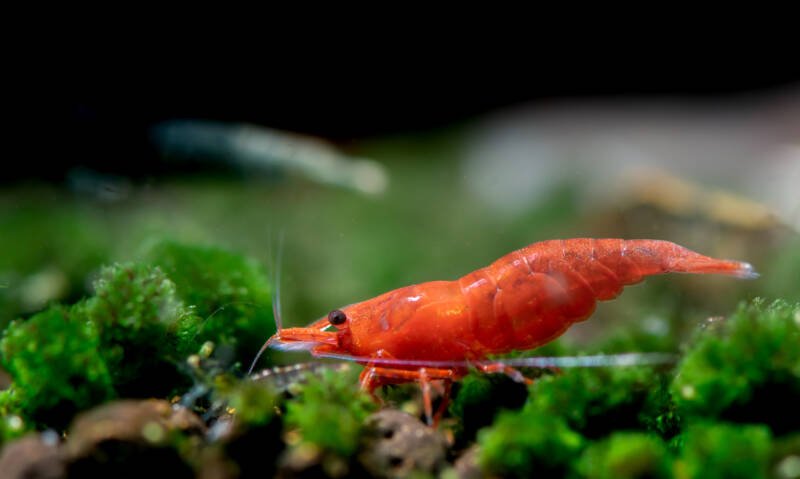
The cherry shrimp is probably the most popular species of dwarf shrimp kept in captivity. Originating from the cool waters of Taiwan, this species is very peaceful and grows to a maximum size of 1.4 inches (3.5 cm) in length.
In the wild, they come in varying levels of red and amber. Interestingly, in the aquarium trade, you will mostly find them in a deep shade of red, presumably due to generations of selective breeding.
While there are different grades of cherry shrimp in the trade today, the lower grades are still a nice deep red and are usually available for cheap (another reason why they are popular).
Possibly one of the easiest species of dwarf shrimp to handle, once it gets established, the cherry shrimp also reproduces quickly. The young look like miniature versions of their parents.
Much like their natural habitat, cherry shrimp prefer softer slow-moving water and spend much of their time grazing on biofilm and algae.
The ideal conditions for the cherry shrimp are a pH between 7.0 and 8.0 and a constant temperature of about 70°F (21°C). While they can survive higher temperatures (and tend to breed faster in those conditions), they also tend to lose their colors.
The average lifespan of a cherry shrimp is around two years. Most hobbyists keep them in a ‘species only’ tank due to their ability to hybridize with other species of the same family.
2. Amano Shrimp: Caridina multidentata
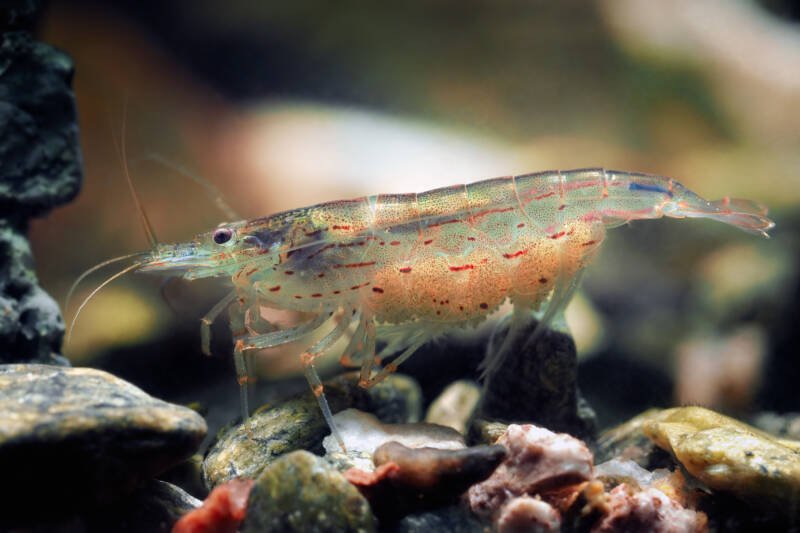
The Amano shrimp has long been employed to clean tanks with algae problems. They are among the best measures you can take if you have this problem in your tank.
That said, the Amano shrimp is a larger species of shrimp that grows up to two inches (5 cm) in length.
In addition, their nosy personalities, coupled with their endless appetite for algae, make them great additions to any community tank. It is also a very hardy species that can handle most novice mistakes well.
Interestingly, the Amano shrimp is notoriously difficult to breed in the home aquarium. Most of the specimens available in the market today are actually wild-caught.
Although they may not be much to look at (they look similar to ghost shrimp), they make for amazing cleanup crews thanks to that notorious appetite of theirs. Most keepers employ them for algae control and to clean up leftover food.
This species can accept a wide range of water parameters. A pH range of 6.0 to 7.0 and a temperature range between 68°F and 75°F (20-24°C) is great for them.
3. Crystal Red Shrimp, Crystal Black Shrimp, CRS, CBS: Caridina cantonensis

Long considered the holy grail of dwarf shrimps, the crystal red shrimp (CRS) is an exquisite-looking creature that displays white and red stripes.
Interestingly, the CRS is actually the albino variety of the crystal black shrimp (CBS).
The CRS was the result of line breeding an albino mutation that initially belonged to a breeder from Japan named Hisayasu Suzuki. Most, if not all CRS today are the result of that single mutation from his broodstock many years ago.
Much like the cherry shrimp, the CRS and CBS both have different grades. Usually, breeders aim to bring out the coloration (red or black) to the most vivid level possible.
The CRS and CBS have identical requirements. A pH of 6.5 to 7.0 and a temperature between 66°F and 73°F (18-23°C) are best.
The CRS is more susceptible to parameter fluctuations because it is heavily inbred. However, as a species, they are relatively hardy and quickly reproduce once established in an aquarium.
4. Snowball Shrimp: Neocaridina zhangjiajiensis

Much like the cherry shrimp, the snowball shrimp is a hardy species that is great for beginners. It grows up to 1.5 inches (4 cm) and survives well in most water conditions.
Although the species originated in Taiwan, the common aquarium snowball shrimp was originally bred in Germany.
They are milk-colored and depending on the variation, their colors can vary from opaque to a deep blue (sometimes also called the blue pearl shrimp).
Generally easy to feed and care for, the snowball shrimp is extremely prolific once established in the aquarium. The young are miniature versions of their parents and require no extra care.
Feeding dwarf shrimps is not difficult as they will readily feed on any food item that falls to the bottom of the tank. The challenge is to control their feeding to reduce the amount of excess nutrients in the tank.
As for water parameters, they have similar requirements to the cherry shrimp. A pH value between 7.0 and 8.0 and temperature values between 70°F and 75°F (21-24°C) will do them well.
Tank Size: How Big Should You Go?
Unlike traditional fish tanks, bigger shrimp tanks are not always easier. This is mainly because they are tiny creatures and the large territory will hinder their ability to feed effectively.
Most shrimp keepers tend to limit the size to about 75 gallons of water (284 l). However, 10- to 15-gallon tanks (40-55 l) are common as well.
Having a smaller tank (but not too small), helps the keeper more effectively manage the feeding and removal of a dead pet.
Although big tanks have fewer water parameter fluctuations, the amount of work spent on upkeep just for shrimp usually outweighs the benefits.
How many shrimps should you keep per gallon of water?
As a general rule of thumb, we limit our shrimp populations to no more than 5 individuals per gallon of water. That said, if you are capable of maintaining pristine water conditions in your tanks, that ratio can go as high as 15 shrimp per gallon.
Of course, this is only for the dwarf shrimp species that grow to a maximum length of about 1.5 inches (4 cm).
Unlike fish, shrimp generally do not do well with strong water flow. As such, maintaining proper water quality can be difficult. Make sure you have the proper filtration system.
Shrimp Tank Equipment
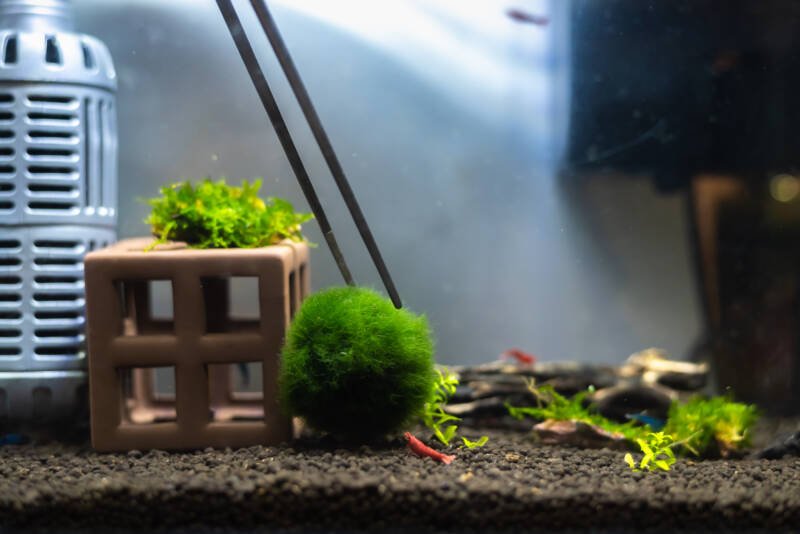
The general equipment list of a shrimp tank is a bit different from a traditional fish tank.
Tank
For the most part, there is no special requirement for the tank except that it be large enough for your shrimp population. As mentioned above, our rule of thumb is about five shrimp per gallon of water.
Filtration
Filtration is tricky with shrimps, mostly because keepers tend to maximize flowrate to cycle the water as many times as possible to reduce the bioload. However, shrimp are likely to die if the flow rate is too high.
Most shrimp keepers opt to use sponge filters for smaller tanks. The tricky bit about filtration is that shrimplets often get sucked into the filter and die. Hence, whatever filtration device is used, it is best to cover the inlet with a pantyhose or sponge.
Heater
This piece of equipment is necessary if you live in colder climates. Heaters are essential in these parts of the world because although shrimps tend to do much better in colder water than in warmer, they will die if the water gets too cold. The sweet spot is somewhere around 68°F or 20°C.
Most heaters nowadays come with an integrated thermostat which can help you regulate the temperature in your tank.
Thermometer
A thermometer is a must in every tank. Temperature is an essential parameter, and shrimps do not do well when it fluctuates. Thankfully, most thermometers nowadays are digital and relatively affordable.
Lighting
Lighting is an important biological factor when it comes to raising dwarf shrimp. They are most active around dusk and dawn. We generally recommend a photoperiod of about 12 hours to mimic what they have in the wild.
Test Kits
Test kits are important tools in every hobbyist’s arsenal. We can’t stress enough how critical it is to understand what goes on in your water, even when just raising shrimp.
Knowing what goes on in the water will give you pinpoint accuracy in finding a solution to a problem.
Many hobbyists make the mistake of guessing what’s wrong when in reality, a simple test will tell you the issue straight away. Yes, test kits can get expensive, but it is an investment that will bring your hobby to the next level.
Water Conditioners
Possibly the most important piece of equipment to have is a good water conditioner.
Most of us use tap water to fill up fish tanks and change the water. While tap water in itself is great for us humans, it usually isn’t very good for aquatic animals.
What comes out of the tap often contains traces of chloramine or chlorine. The specific amounts vary depending on where you live. Also, tap water has other additives that are safe for us but not for the inhabitants we hope to keep.
A good conditioner removes most of these additives and makes the water safe for use in the aquarium.
Invertebrates are far more sensitive than fish regarding foreign additives in the water. A little chlorine can kill your entire broodstock of shrimps overnight and is not something to be trifled with.
Decorations
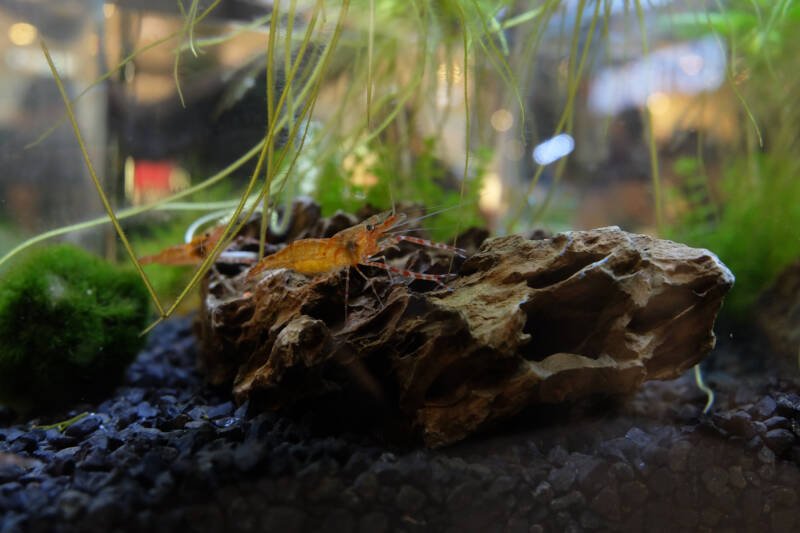
Shrimp tanks are rarely bare and for a good reason. Adding decorations to the tank will increase the surface area on which biofilm and algae grow.
While that can sound bad, it really isn’t, considering that shrimps feed almost exclusively on biofilm and algae. It only becomes a problem if you fail to consistently maintain the tank.
Some decorations like aquatic soil also help to buffer the water. This is great because apart from beautifying the tank, it also helps to prevent pH crashes.
Live Plants
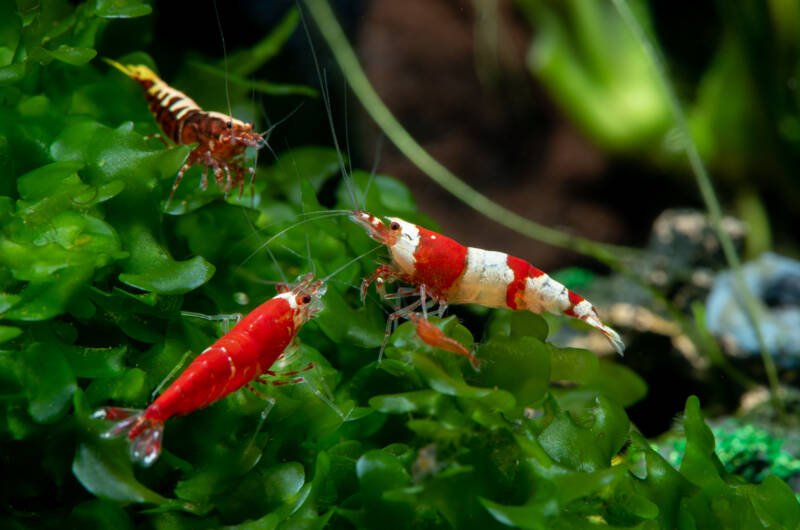
Often the most popular choice of décor, live plants not only provide a place for your shrimp to seek shelter but also help oxygenate the water.
Some common options for live plants are java moss and java ferns. They are hardy plants that grow quickly and require little to no care. However, it is important to note that all plants need proper lighting to survive.
Fake Plants
If live plants seem like too much of a hassle, fake plants will also work. Although they don’t oxygenate the water, they will still provide shelter and food (biofilm and algae) for your shrimps.
Driftwood
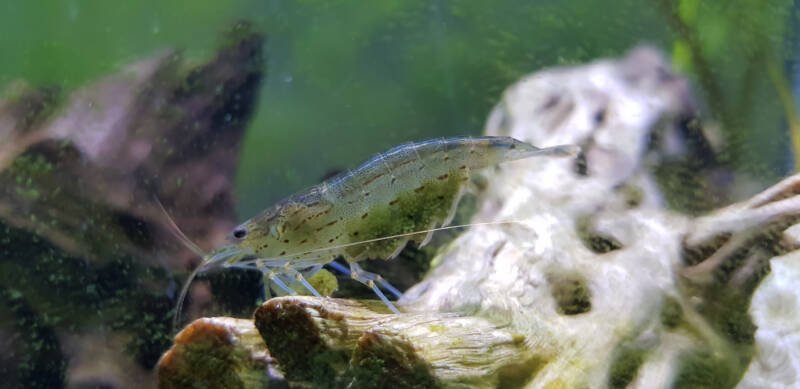
Another common addition to shrimp tanks, driftwood is an excellent choice for décor. Driftwood is a good option because it provides a surface for biofilm and algae to grow on.
However, in recent years, shrimp tank owners have leaned toward cholla wood instead of the traditional driftwood.
Unlike driftwood, cholla tends to disintegrate faster and creates a biofilm layer as it decays. Cholla wood is also said to have better buffering properties than traditional driftwood.
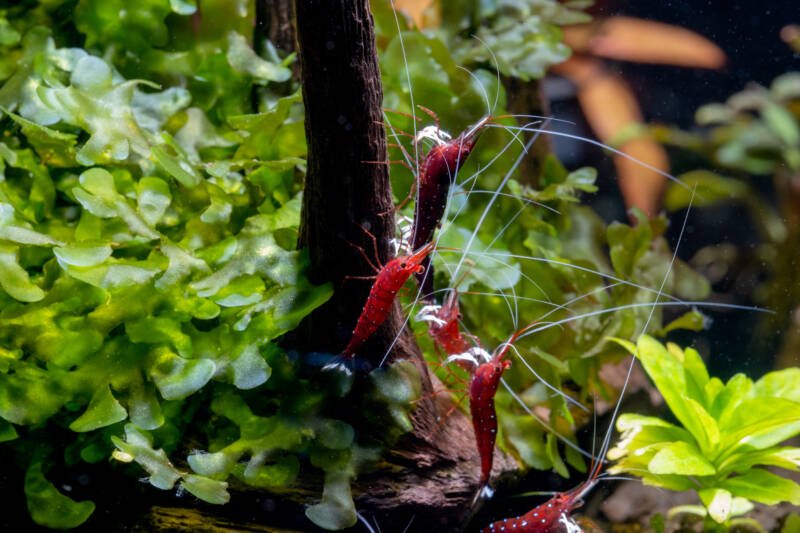
Rocks
Rocks are a great choice of décor as long as they are properly washed before adding to your shrimp tank. They provide an added surface for the growth of beneficial bacteria. This will help reduce excess nutrients in the tank.
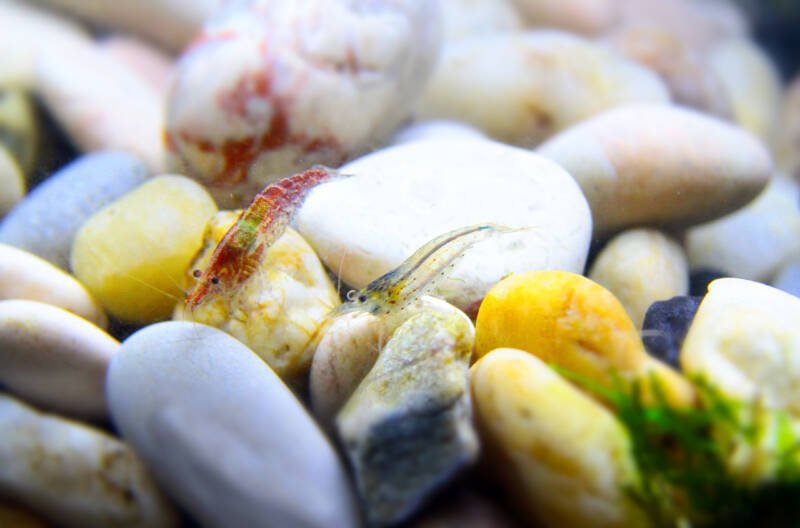
Tankmates
Unlike traditional community tanks where owners usually only have to worry about the aggressive species, it is very much different with shrimp tanks.
Shrimp are tiny creatures that stress easily. Even seemingly harmless fish like guppies will be an issue. Furthermore, if you are expecting babies from your shrimp, chances are they’ll get eaten.
Thankfully there are some inhabitants that are shrimp-friendly. Below is a list of species with a proven track record living alongside shrimps:
- Corydoras
- Otocinclus catfish
- Small snails, like MTS
- Small plecos
- Small tetras
- Other shrimp
As a rule of thumb, avoid carnivorous fish, unless, of course, you’d like your shrimp to become quick snacks.
Tank Setup
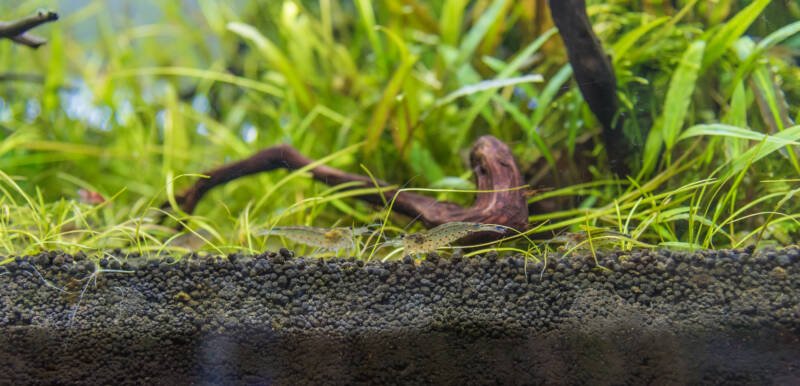
Setting up a shrimp tank is actually the easiest part of the process. Very little hardware is required to create a successful tank.
Dry layout
Over the years, we’ve seen many hobbyists make the mistake of buying everything at one go and wonder what went wrong when their entire tank goes belly up.
Always start with a dry layout of the tank first. Think about how you want the tank to look and make adjustments if you need to before actually pouring any water in it.
Doing this not only reduces the need to change the layout once the water has been added, but also prevents spikes from happening while you do so.
You can also include any plants that you want to add to the tank so that you don’t have to do it later on. After you have a good picture of the layout, pour the substrate in a layer 1-2 inches (2.5-5 cm) thick and follow that with your other decorations.
Do note that shrimps are very fragile so it is best to use objects that do not topple easily.
Water and Cycling
Once you’ve got the perfect layout, it’s time to add water into the tank. But before you go rushing off to the tap, remember that you will need to condition the water first. After the water has been conditioned, you can slowly add it to your tank.
Pro-tip: PLACE A PLATE at the bottom of the tank and pour the water onto it, to prevent the water from tearing up your aquascape.
Now that the tank is filled, you must wait. The contents of the tank need to complete a full nitrogen cycle.
Cycling the tank is a critical step in the aquarium hobby. It basically allows your tank to build up sufficient bacteria to handle the bioload to come. It takes up to a month for your tank to go through the cycle fully. Some hobbyists also employ fast-startup bacteria to hasten the process.
Adding Shrimp
Once the cycling is finished, use a test kit to confirm everything is where it needs to be. Nitrates, nitrites, and ammonia should all be at undetectable levels.
Adding shrimp into the tank is a relatively easy task. The key to success is to do it slowly.
Most owners opt to drip acclimatize their shrimps. To successfully do so, you will need a few pieces of equipment:
- Container to place your shrimps into temporarily
- Clips
- Air tubing.
Place your shrimps in the container. Tie a knot at one end of the air tubing and fill it with tank water. Then use the clips to hold the tubing in place, one end (the end without the knot) in the tank and the other end (with the knot) on the shrimp container.
If done successfully, water should begin to drip into the container. One drip per second is usually the rate we aim for but you can do it slower if that makes you more comfortable.
After about an hour of drip acclimatizing your shrimp, they should be ready to go into their new homes.
Pro-tip: NEVER pour water from the transport bag into the tank; instead, net your shrimps and place them into their new tank.
Maintenance
Shrimp tank maintenance is usually easy and should not take much of your time.
Usually a 10%-20% water change once a week will suffice to keep everything in check. Remember to condition your water properly before the water change.
Feeding schedules are easy as well. There is generally a lot of food in the tank – we just can’t see it. We usually feed our shrimp a pinch of food once every 2-3 days and very sparingly. Most store-bought shrimp food will suffice.
It is also important to clean out your filter once every 2-3 months, depending on the bioload of the tank and how much excess food you add. Only wash your filter media in existing tank water.
Closing Thoughts
Dwarf shrimps are fascinating creatures to keep and can be extremely therapeutic to boot. They reproduce quickly and are generally very easy to manage once you get the tank up and running.
Shrimp are quite different from fish, so it’s important to always take things as slowly as possible. Raising a successful shrimp tank can be quite an accomplishment. One of the marks of success is reproduction.
Do leave us questions and comments below!